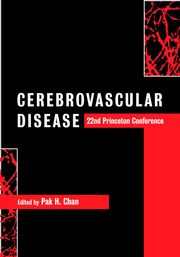Book contents
- Frontmatter
- Contents
- List of contributors
- Preface
- Acknowledgments
- Part I Special lectures
- Part II Oxidative stress
- 3 Peroxynitrite and injury to the vasculature and central nervous system in stroke and neurodegeneration
- 4 Interaction between inducible nitric oxide and cyclooxygenase-2 in ischemic brain injury
- 5 Mechanisms of ischemic tolerance
- 6 Clinically tolerated NMDA receptor antagonists and newly cloned NMDA receptor subunits that mimic them
- Part III Apoptosis
- Part IV Hot topics
- Part V Hemorrhage, edema and secondary injury
- Part VI Inflammation
- Part VII Gene transfer and therapy
- Part VIII Neurogenesis and plasticity
- Part IX Magnetic resonance imaging in clinical stroke
- Part X Risk factors, clinical trials and new therapeutic horizons
- Index
- Plate section
3 - Peroxynitrite and injury to the vasculature and central nervous system in stroke and neurodegeneration
from Part II - Oxidative stress
Published online by Cambridge University Press: 02 November 2009
- Frontmatter
- Contents
- List of contributors
- Preface
- Acknowledgments
- Part I Special lectures
- Part II Oxidative stress
- 3 Peroxynitrite and injury to the vasculature and central nervous system in stroke and neurodegeneration
- 4 Interaction between inducible nitric oxide and cyclooxygenase-2 in ischemic brain injury
- 5 Mechanisms of ischemic tolerance
- 6 Clinically tolerated NMDA receptor antagonists and newly cloned NMDA receptor subunits that mimic them
- Part III Apoptosis
- Part IV Hot topics
- Part V Hemorrhage, edema and secondary injury
- Part VI Inflammation
- Part VII Gene transfer and therapy
- Part VIII Neurogenesis and plasticity
- Part IX Magnetic resonance imaging in clinical stroke
- Part X Risk factors, clinical trials and new therapeutic horizons
- Index
- Plate section
Summary
Introduction
Oxidative stress is a widely recognized but poorly understood component in stroke and neurodegeneration. Antioxidant enzymes as well as a variety of low molecular weight antioxidants can be remarkably protective in animal models in stroke, trauma and neurodegenerative diseases. However, the targets and even the nature of the reactive species themselves have so far been poorly delineated. The extraordinary reactivity of some oxidants such as the hydroxyl radical has masked the search for specific targets of oxidative damage in vivo. Growing evidence indicates that oxygen radicals can produce remarkably specific actions far upstream in signaling cascades that can initiate apoptosis in neurodegeneration. In addition, oxygen radicals exert an important role in promoting thrombosis and permeability increases in the vasculature that can greatly complicate the final outcome from stroke. In this chapter, we will review how oxidative stress resulting from the interactions of superoxide with nitric oxide could be involved in damage both to the cerebral vasculature and to neurons in stroke.
Oxygen toxicity and superoxide
A strong case can be made for molecular oxygen in the air we breathe being the most dangerous toxin and carcinogen in the environment. From a thermodynamic point of view, molecular oxygen is capable of oxidizing any biological molecule and routinely does so as the terminal electron acceptor in normal metabolism. However, the rates of such reactions occurring spontaneously with oxygen are quite slow, which allows us to exist in an atmosphere containing 20% oxygen.
- Type
- Chapter
- Information
- Cerebrovascular Disease22nd Princeton Conference, pp. 23 - 46Publisher: Cambridge University PressPrint publication year: 2002
- 1
- Cited by



